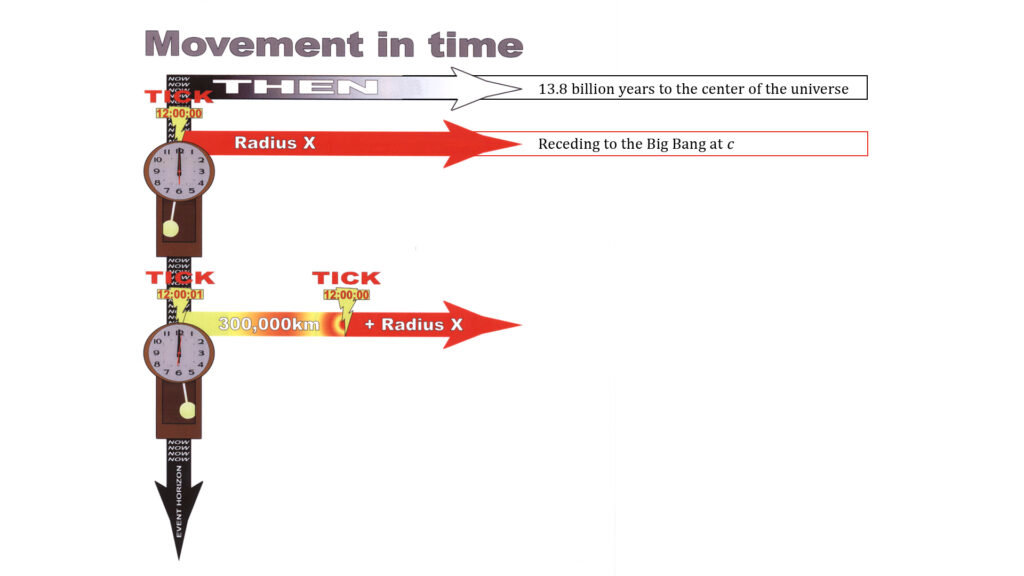Download this chapter for offline viewing (no videos, 2MB)
Download this chapter for offline viewing (includes video content, 29MB)
What if time does not vary linearly with the change in the Universe’s radius? Kepler established 400 years ago that the periods for planetary orbits changed to the 3/2s power with the radius of the semi-major axis for those orbits. Likewise, time for the Universe changes in the same proportion with the radius of the Universe.
The Uncertain Nature of Time
Time defies definition. Its passage is the most ever-present aspect of life. For this reason we have an intuitive understanding of its nature, but when asked to explain time, we are lost.
Time is like a magical box. We know what it does but have little understanding about its mechanism. Patterns of time movement are learned from childhood, but why those patterns are predictable is not clear. We define time by its effects and how it orders events, but we have great difficulty describing it directly. With all of our experience with its ever-presence in our lives, we know little about time’s nature.
The Arrow of Time
Time is something that we cannot see, but we do sense its passage. We are so certain about its forward movement that we order our lives around prospective future events. We set the clock alarm to begin a day that we are certain will come. We arrange to be at a certain place in space at a predetermined time to meet another individual who creates the appropriate sequence of events to rendezvous at the same place in space and time.
Events form through interaction and leave behind their history. These are placed in a sequence that cannot be reversed. We can move any direction in space, but movement in time is a one-way street.
We can break a glass, but we will never see a glass unbreak. Processes move toward disorder. There is a statistical base to this. There are vastly more states of disorder than order. It takes energy and directed effort to create the glass. The statistical probabilities are tied to the unveiling of the future. It is this aspect of event formation that gives time its forward nature.
Time layers events upon each radius of the expanding Universe. The Universe’s expansion is the true arrow of time. The Universe cannot contract. If it did, then time events would be eliminated with the contraction.
Measurement of Time
For the earliest civilizations time was related almost entirely to the regularity of celestial bodies. Planting was dependent upon the seasons. The Sun’s changing angle marked the seasonal ebb and flow. The day was dependent upon the rise and fall of the Sun above and below the horizon. The waxing and waning moon created a period akin to the month.
The sun dial was one of the first time measuring instruments. The obvious shortfalls were that it required a sunny day and it had no value at night. Time measurement became a matter of observing events with regular periods.
Other instrumentation such as an hour glass, a standardized candle or water clock became crude attempts to measure time. It took many years of human existence before time measurement moved to clocks. The regularity of a pendulum of a particular length created the mechanism. These evolved to ever increasing accuracy.
The pendulum clock had a critical flaw that made it so they could not be used on ships. The movement of the ship would counter the pendulum’s movement and thus render the clock useless. This was a particularly troublesome problem causing sailors to be far off of their targeted locations. While at sea, navigators could always determine their latitude, assuming that the skies were clear, by calculating the angle for the celestial body for that particular day of the year. However, longitude was more problematic. The position in the sky for the sun or stars was only meaningful if the exact time of the day was known. John Harrison, a carpenter in Britain, developed the first chronometer with its pivoting pendulum. Its success improved navigation immeasurably.
More and more sophisticated mechanisms evolved using the regular periods of different natural oscillators. The quartz crystal became the oscillator of choice for many time pieces in the 20th century. Its accuracy was at least an order of magnitude improved over its wristwatch precursor.
Atomic clocks are now considered among the most accurate oscillators. They use materials such as cesium or rubidium for an electronic oscillator and measure the regularity of the radiated frequency.
Long-term time measurement can be calculated by various radioactive decay mechanisms. One isotope of an element can decay into another isotope or a totally different element. This process occurs at a statistically consistent rate. The time period for the decay process is usually measured in terms of the half-life, i.e., the time that it takes for half of the original particles to decay to their lower energy counterpart. The measurement of the decay of carbon-14 to nitrogen-14 has become the standard dating process for materials that are up to several tens of thousands of years old. Dating for very long durations can use uranium decay. Uranium has a 1/2 life of about 4 1/2 billion years. This is the approximate age of the Earth.
These time measuring techniques do not directly measure time. They are a result of observing events that occur in a certain cyclical way. Events are measured, not time itself. We arrange to be in proximity to a particular person at the same time that our watch’s timepiece registers 9:00. The actual flow of time has another mechanism that has been elusive to direct measurement.
Time is the Great Organizer
So time is recognized by the events that fill it. Time places these events in order. As seen from a single vantage point (reference frame) events are placed in sequence. In this way time is the great organizer. It orders events such that one darn thing doesn’t occur right on top of another. While things are separated in space, they are also separated in time.
We have seen that time is also relative. Time flow for one reference frame may vary from another frame. Location in space, movement in space and the curvature effects of gravity all affect the observed sequence of events. This is where the Minkowskian spacetime comes in. The real organization of events includes both space and time. It is these in combination that order the Universe.
Events occur in a unique location in space but also a unique location in time. The time location is actually a spatial location. Each moment in time occurs when the Universe was at a particular radius. This is the radius from the Big Bang, which is equal to the velocity of light times the age of the Universe at the moment that the event occurred. By adding time to the coordinates, every event has a four coordinate address.
Kepler’s Orbital Periods
Johannes Kepler utilized the detailed studies of planetary motion from Tycho Brahe, and from these observations he established three laws of planetary motion.
- His first law is that all orbits are elliptical. The circular orbit is an ellipse with no eccentricity.
- His second law is that the planet or satellite will sweep out an area on the orbital plane for a given period of time that is equal to the area swept out for the same time period anywhere else in the orbit. This relates the velocity of the orbiting body to the area of time.
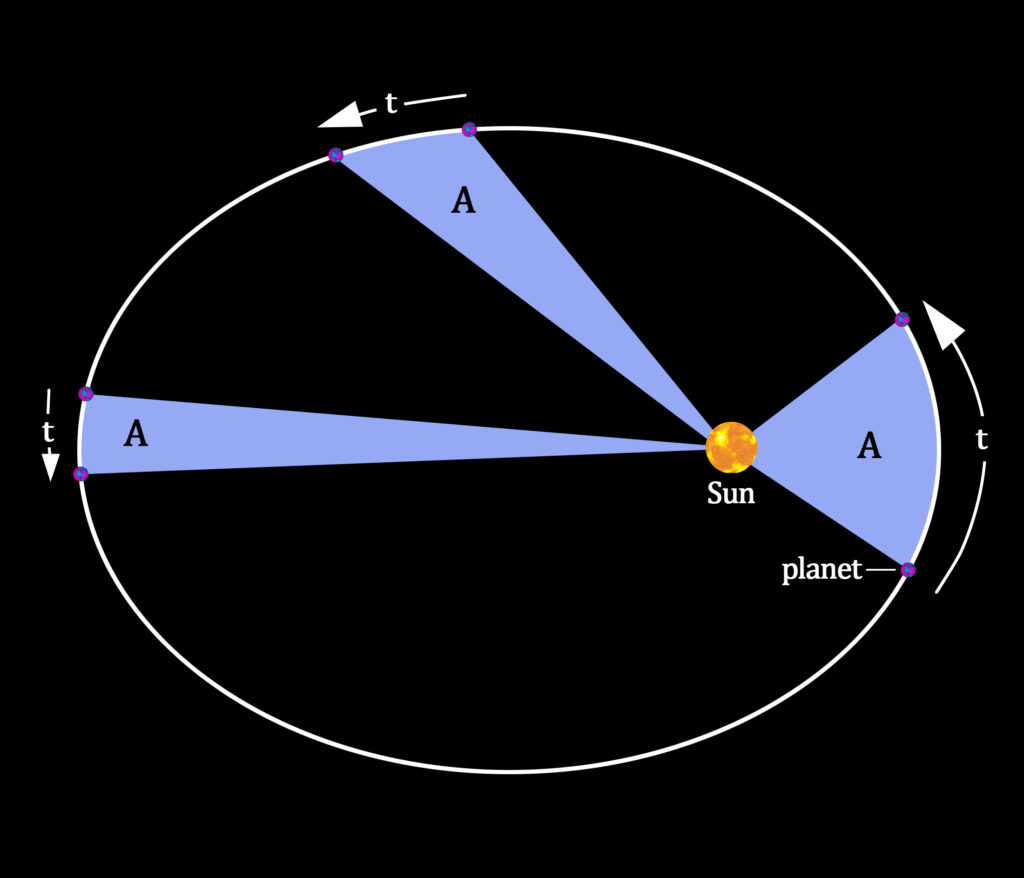
The essence of Kepler’s second law is based in the law of the preservation of angular momentum. Angular moment is momentum with a radial component. Regular momentum rho (ρ) is equal to the mass times the velocity of the mass:

Angular momentum is regular momentum times the radius at any point in the orbit. Velocity and thus momentum vary inversely with radius. When multiplied they are a constant of motion. So for any orbiting mass angular momentum remains constant unless acted upon by a source of orbital torque.
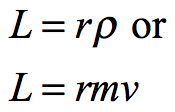
Angular momentum is always preserved so L remains constant throughout the orbit. Since the mass of the orbiting body is the same for all locations of the orbit, r and v vary inversely.
- Kepler’s third law states that the period of an orbit is proportional to the semi-major radius of that orbit to the 3/2s power. This meant that if a satellite orbited Sun at double the Earth’s radius (2 AU), it would complete an orbit in 23/2 years or 2√2 years.
The 3rd law applies to wherever there is a central mass that greatly exceeds the mass of the revolving satellites.

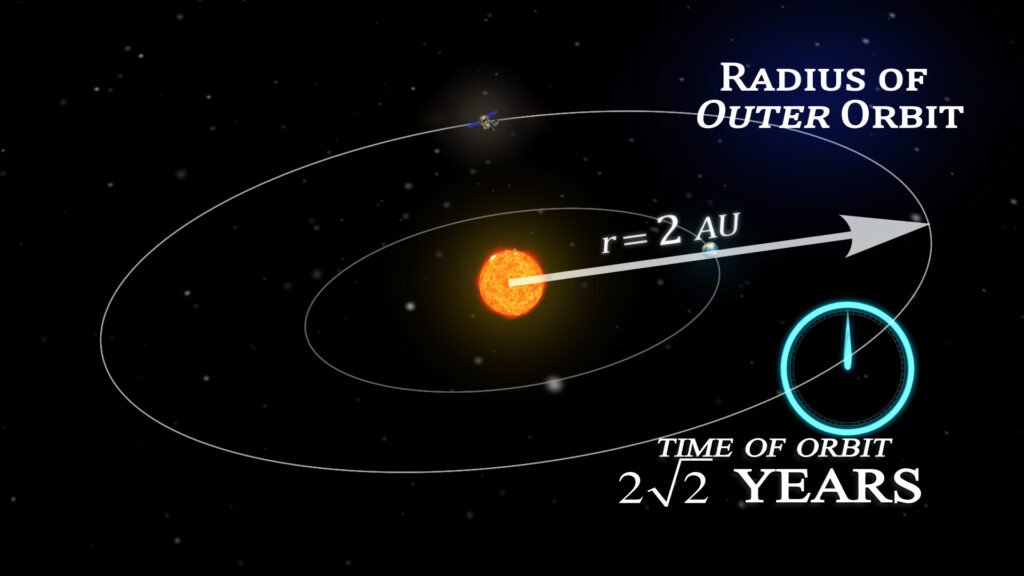
Gravity and the Nature of a Sphere
The only rational shape for the Universe is spherical. Space expanded from an extraordinarily dense location, i.e., the Big Bang, to its current dimensions. A spherical mass behaves as if the entire mass resides in the center of the sphere. In this way the Universe acts as if it has a central mass residing at that center. Since the center of the Universe is the Big Bang, then the Universe behaves as if its gravity acts from that location. So just like the solar system, the Universe has a central mass that acts on all that resides therein.
Time and the Universe
The current age of the Universe is estimated to be 13.798 billion years. Since there are 31558150 • 107 seconds per year, the age in seconds is 4.35439 • 1017 s.
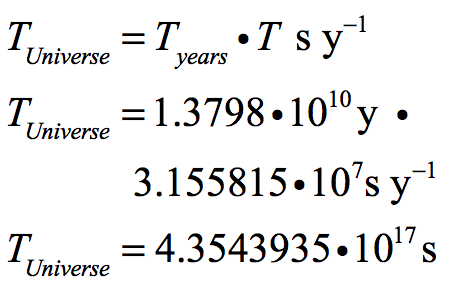
When the Universe was half the current radius, what was its age? Was it 1/2 its age or not? Is there any mechanism that determines the relationship of age to the Universe’s radius?
Since the Universe is a gravitational system, what if time changed to the 3/2s power with the proportionate change in the Universe’s radius? This would mean that when the Universe was half the current radius, its age was half to the 3/2s power of the current age. Thus time would not have a linear relationship with radius. The age of the Universe would have been:

This means that time is accelerating. The increase in radius of the Universe exacts an even faster increase in age. This is in keeping with Kepler’s 3rd law.
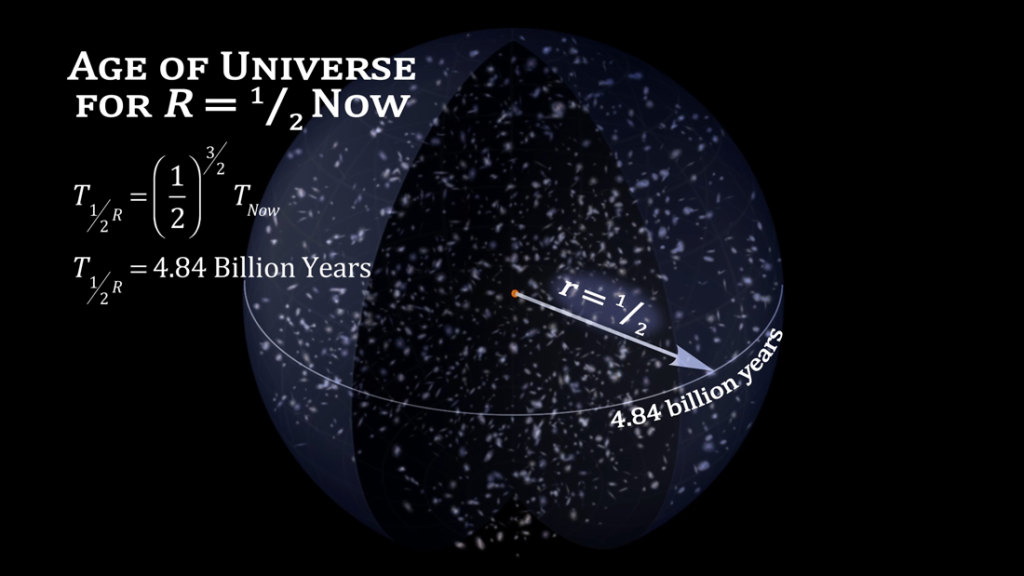
CBR Event
The flow of time in the past cannot be easily observed for one basic reason. When we observe the past, we see it through the lens of the present and the current flow of time. A test of this hypothesis needs to include a measure of proportionate radius of an event in the past and the time when that event occurred.
The most ubiquitous observable event in the Universe is the release of the cosmic background radiation. For a time, the early Universe consisted primarily of hot hydrogen plasma with some helium and trace amounts of lithium. The temperature was sufficiently high to keep the hydrogen electrons from settling into a stable orbit around the proton nuclei.
The CBR event occurred when the temperature of the Universe cooled to the deionization temperature of hydrogen gas, i.e., 3,000°K. At that moment, the free electrons found a nucleus to attach to in a cosmic equivalent to musical chairs. The hydrogen ions quickly neutralized to form atomic hydrogen. Local space rapidly became transparent since neutral hydrogen only weakly interacts with light.
One year after the CBR event local space appeared to be empty, but one light year away could be observed a hot boundary of gas seen one year in the past when hydrogen was still decoupled. Every year this margin moved one light year further away. As time passed, this margin appeared to be receding from the present. This caused the light signal to red shift. The Doppler shifting of the black-body radiation1 of the CBR event caused the apparent temperature to decline.
We can observe the receding CBR envelope as electromagnetic radiation in the microwave frequency range of the spectrum. The apparent black-body radiation temperature is now 2.725°K. The temperature of radiation is dependent upon wavelength and its corollary, frequency. Wavelengths of light increase in step with the proportional increase in the Universe’s radius. As space expands, the wavelengths of light traversing space increase. The ratio of the temperature of the CBR event and its current observed temperature is approximately 1,100/1. As a factor of 2, this number is 210.10328781 which means that the Universe has undergone 10.10328781 doubles of its radius since the CBR event.
Increase in the wavelength of light since the CBR event:

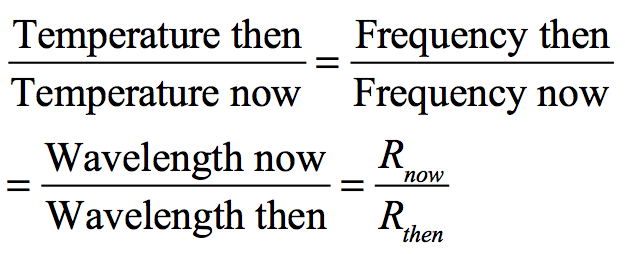
The wavelength of the light has increased over the last 13.798 billion years 1,100 times. This is equal to the increase in the size of the Universe since that event. In order to determine the age of the Universe at the time of the CBR, the ratio of the Universe’s radius (now to then) needs to be taken to the 3/2 power times the current age of the Universe.

If time changed to the 3/2’s power of the proportional change in the Universe’s radius, then the Universe’s age has undergone 10.10328781 • 3/2 or 15.15493171 doubles. Assuming that the age of the Universe is 13.798 billion years, then the age of the Universe during the CBR release was 1/215.15493171 its current age or occurred 378,205 years after the Big Bang. The accepted age for the CBR event is 380,000 years, which is a statistically insignificant difference between the calculated age of the Universe and the generally accepted age.
Time is Experiential
A one year old baby that ages to two, experiences that year completely differently than her grandfather who aged from 60 to 61. For the baby that year is a doubling of its life, while for the grandfather it is a 1 2/3% increase in his life. The experiences of the baby accumulate off of a minimal database. The grandfather has a much larger database accumulated over his years of experience.
A fly has a greatly slowed view of time allowing it to see a hand slowly moving toward it while it leisurely decides to take off moving his entire body out of the way.
A full human life may be 80 years while a dog may only average 12 years. To a dog that is a complete life in the same way that it is for the human. For the human, the dog’s passing is a sad experience within a much longer human life.
| Appendix A: The spreadsheets in Appendix A and Appendix B are used as experiments in the Universe’s experience. In each spreadsheet the Universe is reduced in half multiple times until the dimensions of the Big Bang are reached. |
Time Accelerates for the Universe as the Mass of Experience Accumulates
Experience is retained. That experience increases in mass as the Universe ages. That history is recorded for all time. Just like the aging person, the aging of the Universe accelerates the experience of time. The universe becomes a more massive entity, and with that mass comes accelerated experience. That acceleration means that time accelerates also.
Just like a tiny particle’s interaction in the subatomic world looks incredibly fast to us. It is slow to the interacting particle. The early Universe was entirely that of tiny particles interacting at incredible velocities. Now the dominant nature of things is that of a much more quiescent universe with significantly accelerated time experience. Ironically, rapid time means low mass particles at high velocities while accelerated time means slower velocities but accelerated experience.
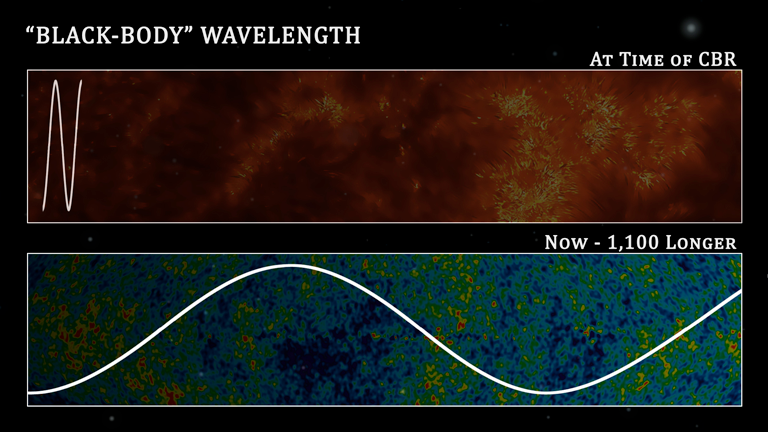
The Present Places Events into the Fourth Spatial Dimension
The Universe catalogues all of its experience. This experience is recorded in the Minkowskian spacetime grid. For each interval of time those experiences are recorded in space at a particular radius for the Universe at that instance of the evolving present.
If a couple is driving in the car at 60 miles per hour (88 feet per second) and the driver throws a map to his wife. At that exact moment he instantly drives a stake through the floor into the pavement beneath. A half second later his wife catches the map and at that instant she drives a stake through the floor into the pavement. The map traveled no more than two feet, but the stakes are 44 feet apart. Even though the map traveled a short distance within the car, the events are 44 feet apart.
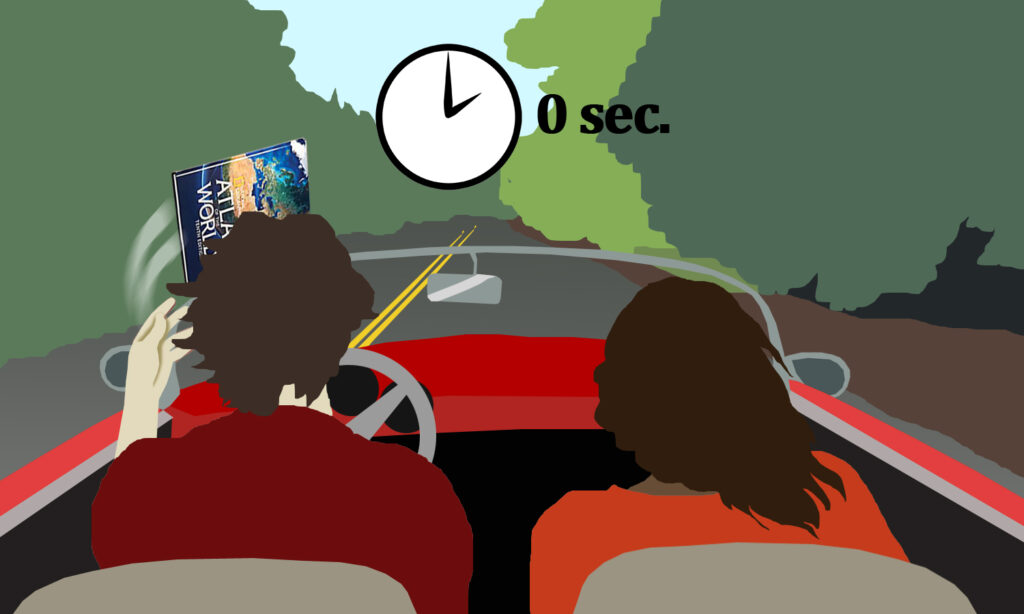
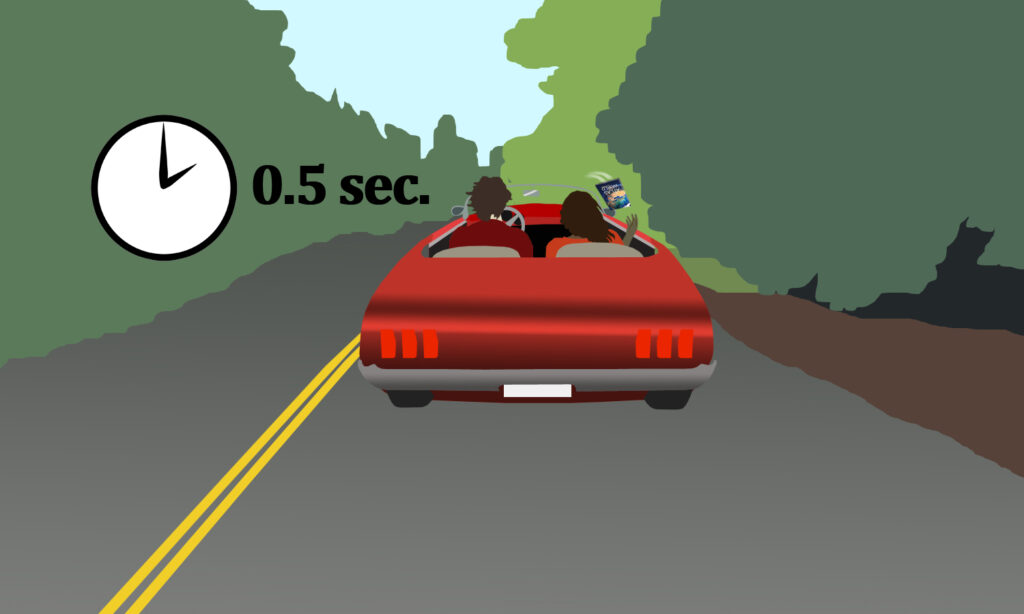

In this way the events of the Universe are recorded. The Universe expands at the velocity of light. While expanding events are forming at each instant of the then-present surface. A second later those past events are 300,000 kilometers behind the event creator.
The mass that generated the events has coasted with the Universe’s expansion to the ever-increasing radii. Events trail in its wake. Everything is layered in the four dimensions of spacetime.
